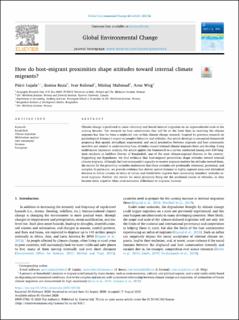| dc.description.abstract | Climate change is predicted to cause voluntary and forced internal migration on an unprecedented scale in the
coming decades. Yet, research on host communities that will be on the front lines in receiving the climate
migrants has thus far been a neglected area within climate change research. Inspired by previous research on
psychological distance’s impact on people’s behavior and attitudes, this article develops a conceptual framework
proposing that spatial, attitudinal, experiential, and social proximities between migrants and host community
members are central to understanding how attitudes toward internal climate migrants form and develop. Using
multivariate regression analysis, the article applies the framework to a survey conducted among over 630 longterm residents in Satkhira District of Bangladesh, one of the most climate-exposed districts in the country.
Supporting our hypotheses, we find evidence that host–migrant proximities shape attitudes toward internal
climate migrants. Although the host community’s capacity to receive migrants matters for attitudes toward them,
the results for the proximity variables underscore that these attitudes are profoundly relational, positional, and
complex. In particular, we provide evidence that shorter spatial distance to highly exposed areas and attitudinal
distance to fellow citizens in terms of values and worldviews improve host community members’ attitudes toward migrants. Further, the results for social proximity bring out the positional nature of attitudes, as they
become more negative when socio-economic differences to migrants increase | en_US |

